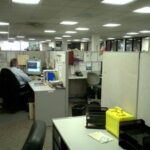In one of the biggest blunders in worldwide invention history, the office cubicle was not only made over into something worse than what it was intended to be, but its current nightmarish form was given the blame to its principal creator. It’s hard to imagine more of a slighted feeling than going to your grave knowing your name will always be associated with what many people consider one of the biggest blights to the work force who are trapped working in offices. And, it’s really perplexing why part of the creator’s original office design hasn’t stayed the same as it should have. Perhaps all offices should go back to the original design before those working in offices completely lose their sanity. Then again, we’d lose a good chunk of satiric pop culture if we did.
It was inventor Robert Propst who came up with the essential concept of the cubicle, though through an overall office design called the Action Office. Propst was really a brilliant inventor of office design and general thinker in how to make a larger work-related area better. He had 120 patents on designs and systems that were employed in not just offices, but also in general labor type of situations such as the timber and livestock industries. Even one of his creations, a mobile office, was invented for a paraplegic lawyer that almost sounds good for anybody trapped all day in an office and needs a change of scenery.
Even though the basic structure of the office was already a living nightmare in the early part of the 20th century, there were always plans by organizations that had big offices to improve the design. They usually just made it worse what with a sea of parallel desks, no privacy and little space to move around in. Propst was fascinated by a lot of this during the early 1960’s when the office hadn’t really evolved into anything that would promote a more psychological feeling of comfort and inspiration toward wanting to stay there and get more work done. It was more of a feeling of a torture chamber and instigating habits of looking at the clock every few minutes to see if it was 5:00 p.m. yet.
Propst figured out an office layout that would address every issue of what office workers complained about. Outside of the privacy aspect and increasing productivity, he also created ergonomically-efficient office chairs and desks that were designed to be worked on while standing up to help employees be able to change their position during the day to prevent people having to sit for too long of periods.
Sounds like something from a long-ago utopia in the modern office sense, doesn’t it?
Well, when Propst and the company he worked for (office equipment maker Herman Miller, Inc.) marketed what they called the new “Action Office” almost exactly 40 years ago as of this writing, the office world went crazy for it. During a time when America was having a nervous breakdown, at least offices in America would get a makeover and prevent nervous breakdowns in the white-collar world.
How the cubicle went from efficient to looking like a monolithic mouse maze…
In Propst’s original Action Office design, the cubicle was actually a collection of medium-size partitions that didn’t conceal a worker completely–yet were placed at certain angles so it would provide one’s own personal work space and not feel as if a fellow employee was invading your personal space all day long. The general layout of a Propst office, too, was created at either a 90 or 120 degree angle so everybody would be facing away from one another and could focus better on their particular projects. Yes, there really isn’t any worse feeling in a work environment then someone having to stare at you all day long, especially if it’s the head honcho of the company. That’s the way it was in offices prior to 1968.
Naturally, Propst’s office design kept getting improved in the ensuing decade and may have been the true golden age of an efficient office. Then the computer age started in the early 80’s along with other office design companies taking Propst’s basic design and making the usual mistake of thinking it could be improved upon. In the age of having to work on a computer in an office space, these other design companies thought it would be brilliant to make those partitions in Propst’s design look akin to the monoliths in “2001: A Space Odyssey.” That was facilitated merely as a method of enclosing employees into a 100% private work area as if having their own little room.
Somehow they didn’t stop and realize that staring at a giant wall all day would take away a feeling of well-being and office productivity.
I personally remember when the enclosed cubicle started in the early 1980’s when visiting my mom’s office where she worked. Prior to that, I actually also remember seeing Propst’s Action Office design in its final original form with the smaller partitions that didn’t give the feeling of the walls literally closing in on you. Seeing taller cubicle walls for the first time in a work space, though, seemed cool as a kid–mainly because the idea of privacy (and having space to hang up pictures and file bins, etc., on the walls) seemed to be fun with the thought you could feel more at home. Little did I understand how it could drive you mad after being around it for months or years. Fortunately my mom retired before cubicles got worse.
____
What truly went wrong with the newer cubicles was in the angular structure of them that gave you the feeling that when you went to visit your fellow employees at their desks nearby, it felt as if you were in a mouse maze. Of course, the term “cube farm” has been employed practically everywhere from “Dilbert” to NBC’s and U.K.’s “The Office.” The thought, also, is that because employees are enclosed in their personal office spaces for so long without any contact with fellow employees, it can make a person less inspired and more apt to slack off in getting work done.
Yep, Propst took that into consideration and realized that productivity involves feeding off the energy of fellow employees around you without necessarily having them being able to witness every nose scratch you happen to do during a work session.
____
It should be noted that Propst’s famous Action Office designs are still available through Herman Miller, Inc. and still have a lot of brilliant ideas that aren’t used in all American offices. If you work in an insurance office, for the government or for most corporations, you’ll see the more modern and nightmarish cubicle design still in use, despite studies and pleas from employees to create something more efficient. The Action Office design might cost a little more–and, hence, there’s your biggest problem in the corporate world where many companies just don’t want to spring the money to change for the benefit of the employees. No wonder nothing gets done right in corporations anymore.
The worst of it is that Propst died in 2000 with the “the inventor of the cubicle” branded to his name. This article is in tribute to Propst and reminding people he didn’t (didn’t, didn’t, didn’t) create the cubicle as we know it today. In fact, he called the cubicle something resembling “monolithic insanity”, which is probably the sharpest put-down of inferiority ever uttered.
We’re certainly a country of thinking we can better things when those things were generally brilliant long before our modern idea people felt they needed to earn a check. When you see the designs of the Action Office at the link below, you’ll wonder why every office doesn’t employ the same design…
http://www.hermanmiller.com/CDA/SSA/Product/1,1592,a10-c440-p6,00.html




